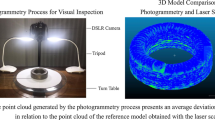Abstract
The paper deals with development and application of a method which allows to perform automatic check the surface integrity of the monitored component. In our case, it is the bearing race of the rotating cylindrical container of the lime regeneration line in the paper mill factory. By visual checks, some cracks have been discovered on the circular surface of the race. These cracks have needed to be monitored to prevent fatal failure. To measure the cracks manually, it was always necessary to stop the cylinder. However, these breaks have caused momentous problems in the operation of the line, which is conceived for continuous work due to the nature of the production process. This was the main reason for the development and deployment of the automated system. Because the problem takes of low-frequency bearing run (less than 1 Hz) moreover used in outdoor conditions an image processing technology was chosen to create a tracking system to determine the immediate crack length at specified times.
Due to the very limited time span for the development of a separate robust apparatus and with regards to the fact that the system is used only till replacing the concerned race with a new one, i.e. for a period of about three months, the hardware of the apparatus was based on a standard web camera with full HD resolution connected to a notebook with a controlling and recording software created in the Matlab environment. This “recording” system located close to the monitored bearing is wirelessly connected to the “controlling” computer placed in the control center of the paper mill. The system reduces the data stream of optical scanning of 750 mm wide bearing ring by cut of the recorded figures to a data level that reliably enables their further processing and evaluation. It is done by the control center computer.
The system is able to indicate individual cracks present at the bearing ring surface with image data processing. Documentation and assessment of development of the dimensions of identified and observed cracks are also presented.
For a better idea about all aspects of the problem, we add that the ring has the diameter of 4.7 m and scanning width of almost 800 mm due to additional axial motion.
Access this chapter
Tax calculation will be finalised at checkout
Purchases are for personal use only
Similar content being viewed by others
References
Mathworks web pages: https://www.mathworks.com/help/images/ref/regionprops.html
Gao, H., Ai, Z., Yu, H., Wu, H., Liu, X.: Analysis of internal crack healing mechanism under rolling deformation. PLoS ONE 9(7), e101907 (2014). Kuzyk MG, ed.
Acknowledgements (Facultative Field)
This work was supported by project number SGS17/176/OHK2/3T/12 and 121368301825B Steti.
Author information
Authors and Affiliations
Corresponding author
Editor information
Editors and Affiliations
Rights and permissions
Copyright information
© 2019 Springer International Publishing AG, part of Springer Nature
About this paper
Cite this paper
Lopot, F., Hadraba, D., Kubový, P., Hošek, J. (2019). Automated System for Remote Defect Inspection. In: Gheorghe, G. (eds) Proceedings of the International Conference of Mechatronics and Cyber-MixMechatronics – 2018. ICOMECYME 2018. Lecture Notes in Networks and Systems, vol 48. Springer, Cham. https://doi.org/10.1007/978-3-319-96358-7_10
Download citation
DOI: https://doi.org/10.1007/978-3-319-96358-7_10
Published:
Publisher Name: Springer, Cham
Print ISBN: 978-3-319-96357-0
Online ISBN: 978-3-319-96358-7
eBook Packages: Intelligent Technologies and RoboticsIntelligent Technologies and Robotics (R0)




